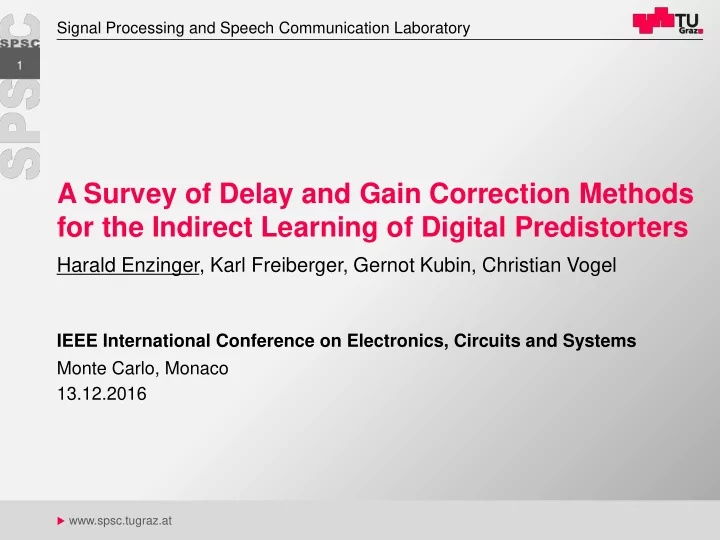

Signal Processing and Speech Communication Laboratory 1 A Survey of Delay and Gain Correction Methods for the Indirect Learning of Digital Predistorters Harald Enzinger, Karl Freiberger, Gernot Kubin, Christian Vogel IEEE International Conference on Electronics, Circuits and Systems Monte Carlo, Monaco 13.12.2016 u www.spsc.tugraz.at
Digital Predistortion (DPD) 2 Digital Enhancement of Wireless Transmitters Identification (ID) Based on inversion: Identify and invert the system. Direct learning: Adaptation of DPD such that . Indirect learning: Identify and use the result as DPD. IEEE International Conference on Electronics, Circuits and Systems 13.12.2016
Indirect Learning Architecture (ILA) 3 Learn the post-inverse and use it as pre-inverse Delay Correction Gain Correction IEEE International Conference on Electronics, Circuits and Systems 13.12.2016
Requirements for the Success of ILA 4 (R1) The postdistorter sufficiently minimizes its error signal. Model Delay-correction (R2) The predistorter operates within the region identified by the postdistorter. Signal Gain-correction IEEE International Conference on Electronics, Circuits and Systems 13.12.2016
Delay Correction 5 Narrowband systems ↔ memoryless models Sensitive to loop delay error High oversampling ratio Fractional delay correction Wideband systems ↔ models with memory Insensitive to loop delay error, if causal & within memory-depth Underestimate for forward-modeling Overestimate for inverse-modeling IEEE International Conference on Electronics, Circuits and Systems 13.12.2016
Methods for Delay Estimation 6 Objective function must be insensitive to Noise Distortion Complex scaling Real-valued objective functions Cross-covariance of magnitudes Cross-correlation of differential magnitudes Distance of local extrema of phase characteristic Complex-valued objective functions Complex cross-correlation between signals IEEE International Conference on Electronics, Circuits and Systems 13.12.2016
Complex Cross-Correlation 7 Linear cross-correlation Circular cross-correlation Zero-padding of signals Periodic extension of signals Further considerations with respect to the definition Direction of shift Conjugation of signal IEEE International Conference on Electronics, Circuits and Systems 13.12.2016
Computation of Cross-Correlation 8 On-Chip Implementation Synchronization, small delay, non-periodic signals Direct computation of linear cross-correlation Lab-based measurements Use periodic input signal Acquire one or two periods of output signal FFT-based computation of circular cross-correlation Frequency domain ↔ Time domain Multiplication ↔ Convolution Conjugation ↔ Conjugation + time-reversal IEEE International Conference on Electronics, Circuits and Systems 13.12.2016
Integer and Fractional Delay Estimation 9 Integer delay Maximum magnitude Fractional delay Parabolic interpolation Correlation Coefficient: IEEE International Conference on Electronics, Circuits and Systems 13.12.2016
Integer and Fractional Delay Correction 10 Integer delay Shift either input or output signal Fractional delay On-chip implementation Farrow filter, efficient technique for interpolation (linear, cubic) Lab-based measurements Sinc-interpolation implemented in frequency domain IEEE International Conference on Electronics, Circuits and Systems 13.12.2016
Gain Correction 11 Considerations for gain normalization Normalization gain Target gain of linearized system Too high gain will lead to clipping (DAC) IEEE International Conference on Electronics, Circuits and Systems 13.12.2016
Automatic Level Control (ALC) 12 ALC controls output power of vector signal generator ALC changes gain depending on signal statistics DPD changes signal statistics Different gain between identification and evaluation Turn off ALC! IEEE International Conference on Electronics, Circuits and Systems 13.12.2016
Methods for Gain Correction 13 Peak Gain Use fullscale without clipping Reduces gain RMS Gain Keeps gain Requires backoff to avoid clipping Both methods are equivalent if the required backoff is considered. IEEE International Conference on Electronics, Circuits and Systems 13.12.2016
Example for Gain Correction 14 Identification from signal without backoff Comparison of gain correction methods The reduction of output power and the required backoff can be calculated by where and are the input and output signal vectors during identification. IEEE International Conference on Electronics, Circuits and Systems 13.12.2016
Conclusions 15 Two requirements for the success of ILA Postdistorter performance ↔ Delay correction Predistorter operation point ↔ Gain correction Delay correction Complex cross-correlation Integer and fractional delay estimation and correction Gain correction Peak gain and RMS gain DPD reduces the output power Performance must be compared at the same output power! IEEE International Conference on Electronics, Circuits and Systems 13.12.2016
Recommend
More recommend